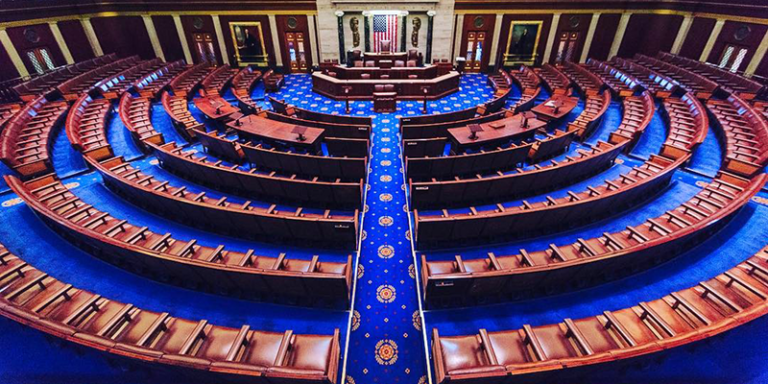
It is official: the Republicans’ reign of simultaneous control of both houses of Congress and of the White House is over. As of Thursday, November 8, 2018, and while some House races are still undecided, Democrats netted 223 seats in the House of Representatives, leaving them with five more seats than the 218 necessary to control the speaker’s gavel. In all likelihood, the Democrats will finish with a net gain of 34 or 35 seats in the House. This is an impressive showing, but it is a far cry from the anticipated “blue wave” that many predicted. In fact, historically it is an average showing for the party that sits opposite the aisle of the incumbent president. Presidents Barack Obama and Bill Clinton, who both had higher approval ratings during their first midterms than President Donald Trump enjoys now, suffered much greater defeats in the House than Trump’s party seems poised to lose.
In all likelihood, the Democrats will finish with a net gain of 34 or 35 seats in the House. This is an impressive showing, but it is a far cry from the anticipated “blue wave” that many predicted.
In Senate elections, President Trump and the Republican Party—due to high rural voter turnout and an extremely favorable electoral map—actually did something only achieved four times in the last century: the party gained seats. Races have officially been called in Missouri, Indiana, and North Dakota where GOP candidates defeated the Democratic incumbents. With Republican Dean Heller’s loss in Nevada, Republicans will likely see a minimum net gain of two seats. The party has a chance to flip Democratic-held Florida as well, with the race heading for a recount. And if Republicans are successful in holding off Democratic challenges to GOP-held seats in Arizona and Mississippi, the party could enjoy a total net gain of three seats (the result would be a 54-46 advantage in the Senate, noting that the chamber’s two independents caucus with Democrats).
Divided Government in Washington
What do the early results reveal about the current state of affairs in the United States? How will they impact President Trump’s legislative agenda for the next two years? The fact remains that the United States is currently an extremely divided and polarized country. The Democratic takeover of the House is largely indicative of dissatisfaction with President Trump and his policies across urban and suburban America. Indeed, a handful of moderate, center-right lawmakers from districts in traditionally red and blue states lost their reelection bids in large part because highly populated urban and suburban areas opted to vote for Democratic candidates. In the Senate, on the other hand, where the electoral map includes states with large rural populations (such as North Dakota, Missouri, and Tennessee), voters in rural counties turned out in high numbers and they overwhelmingly supported the GOP candidates’ platforms.
The Democratic takeover of the House is largely indicative of dissatisfaction with President Trump and his policies across urban and suburban America.
The geographic and accompanying cultural and political chasm in the United States will have a direct role in how the Democratic and Republican parties operate internally and with one another. Divisions between the Republican-controlled Senate and the Democratic-controlled House may be compounded by the ideological disunity within the parties themselves. For instance, Democrats in the House could find themselves in a quasi-civil war over the caucus’s direction. Many establishment, middle-of-the-road Democrats (“Blue Dog” Democrats) are fretting over a Tea Party-like takeover of the House Democratic caucus—based on the rise of progressive candidates like Alexandria Ocasio-Cortez in New York and Ayanna Pressley in Massachusetts, and a spate of other outspoken liberal candidates—much like the Republican caucus experienced during the Obama presidency. Though the number of ultra-liberal candidates who won election this week is probably lower than some anticipated, the Congressional Progressive Caucus is poised to grow even more and it could potentially force the likely Speaker of the House, Nancy Pelosi (D-California), to fashion an agenda tilted toward their preferences.
If a cadre of vocal progressives joining the Democratic Caucus in the House tugs the party to the left, the 116th Congress could prove to be the most polarized of any legislature Washington has seen in recent years. As the rising group of progressive liberal newcomers arrives in Congress, the GOP seems to be moving even further to the right due to the influence of its own small but raucous group, the Freedom Caucus. In a year when voters were mobilized by their favorable or unfavorable views of President Trump, some of the safest incumbents up for reelection were members of the House Freedom Caucus, which is composed of right-wing Tea Party Republicans who gained power before the rise of Donald Trump. This group subscribes to a more strident and less compromising brand of conservatism than most Republicans, including those in the Senate majority. Because some of the most competitive races around the country were in moderate Republican districts, the influx of successful Democratic candidates necessarily means that the remaining GOP House members are the stalwart ideological conservatives on Capitol Hill.
For its part, the Republican-held Senate has shifted dramatically to the right as well. Though it has a long way to go before achieving the ideological rigidity of House Republicans, the “greatest deliberative body” in the world is poised to emerge from the midterms as even more conservative and more deferential to President Trump than before. The so-called moderating forces of Republican conservative lawmakers, like outgoing Senators Bob Corker (Tennessee) and Jeff Flake (Arizona), are being upended by retirement, and Arizona’s other Senate seat, vacated by the death of John McCain, became firmly entrenched with a conservative Republican when former Senator John Kyl agreed to hold the position for at least a year. Corker’s replacement and Flake’s potential replacement, like Kyl before them, toe the party’s more conservative line and they will likely prove to be unapologetically deferential to President Trump’s agenda. Moderate Democrats lost in states that Trump won handily in 2016, leaving the Senate with Republicans who profess extreme loyalty—bordering on sycophancy—to the president.
Moderate Democrats lost in states that Trump won handily in 2016, leaving the Senate with Republicans who profess extreme loyalty—bordering on sycophancy—to the president.
Increased Polarization
That leaves the country torn between two parties that are pushing further to their respective ends of the political spectrum. The Democratic base represented in the House wants to see the Trump Administration investigated ruthlessly, while conservative constituents expect senators to fully embrace the Trump agenda in the upper chamber. How these competing interests are balanced will go a long way in determining how well Washington functions over the next two years. In fact, President Trump already spoke about these precarious circumstances, showing a readiness to negotiate with Democrats—but also a willingness to pursue a scorched-earth policy in his battle against the House. One thing that even Democrats recognize about the president is that Trump is not faithfully wed to Republican and conservative orthodoxy. Indeed, the president, who in the past was a longtime Democrat, has flirted with cutting deals with Democrats previously; in that context, there may very well be issues where the two parties could find space to work together.
However, the more realistic outcome is that when the White House is bombarded with the inevitable investigations regarding the administration’s seeming corruption, ethics violations, graft, and general dysfunction, the president and his allies will likely cut off any efforts to work with Democrats. In that scenario, the prospect of getting any routine legislative business completed will prove extremely difficult.

